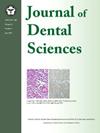无膜干细胞成分抑制破骨细胞分化:对口腔再生治疗的影响。
IF 3.4
3区 医学
Q1 DENTISTRY, ORAL SURGERY & MEDICINE
引用次数: 0
摘要
背景/目的:无膜干细胞成分(MFSCCs)是通过去除带有抗原的细胞膜开发出来的,以克服细胞疗法的局限性,并分离出有效的肽。据报道,MFSCCs 对口腔感染部位有疗效。慢性炎症性疾病会导致骨质过度吸收。在炎症性骨吸收高发的背景下,本研究调查了骨髓巨噬细胞对破骨细胞分化的影响:用巨噬细胞集落刺激因子和核因子卡巴-B配体受体激活剂处理骨髓巨噬细胞(BMMs)。根据 MFSCC 浓度评估破骨细胞的分化情况。使用光学显微镜分析了抗酒石酸磷酸酶(TRAP)染色的成熟破骨细胞和来自 BMM 的多核细胞。使用实时聚合酶链反应(RT-PCR)测定了破骨细胞分化相关基因的信使 RNA(mRNA)表达水平。采用定量 RT-PCR 和 Western 印迹法测定了关键转录因子 c-fos 和活化 T 细胞核因子(NFATc1)的相对表达水平:结果:用MFSCC处理后,细胞存活率相似,取决于BMMs的水平。随着 MFSCC 浓度的增加,TRAP 阳性细胞的数量减少。随着MFSCC浓度的增加,chepsin K、TRAP、树突状细胞特异性跨膜蛋白、c-fos和NFATc1的mRNA和蛋白表达量减少:我们的研究结果表明,MFSCCs 可通过下调转录因子(尤其是 c-fos 和 NFATc1)来抑制破骨细胞的分化。因此,MFSCCs 可以通过抑制过度的骨吸收,作为口腔慢性炎症性骨吸收疾病的一种保守治疗方案。本文章由计算机程序翻译,如有差异,请以英文原文为准。
Membrane-free stem cell components suppress osteoclast differentiation: Implications for oral regenerative treatment
Background/purpose
Membrane-free stem cell components (MFSCCs) have been developed by removing cell membranes with antigens to overcome the limitations associated with cell-based therapies and isolate effective peptides. MFSCCs have been reported to have effects on oral infection sites. Chronic inflammatory diseases cause excessive bone resorption. This study investigated the effects of MFSCCs on osteoclast differentiation in the context of the high prevalence of inflammatory bone resorption.
Materials and methods
Bone marrow macrophages (BMMs) were treated with macrophage colony-stimulating factor and receptor activator of nuclear factor kappa-B ligand. Osteoclast differentiation was assessed based on the MFSCC concentrations. Tartrate-resistant acid phosphatase (TRAP)-stained mature osteoclasts and multinucleated cells derived from BMMs were analyzed using light microscopy. The messenger RNA (mRNA) expression levels of genes related to osteoclast differentiation were measured using real-time polymerase chain reaction (RT-PCR). The relative expression levels of the key transcription factors c-fos and nuclear factor of activated T cells (NFATc1) were determined using quantitative RT-PCR and western blotting.
Results
After treatment with MFSCCs, the cell viability was similar, depending on the level of BMMs. As the MFSCC concentration increased, the number of TRAP-positive cells decreased. The mRNA and protein expression of cathepsin K, TRAP, dendritic cell-specific transmembrane protein, c-fos, and NFATc1 decreased as the MFSCC concentration increased.
Conclusion
Our findings demonstrate that MFSCCs suppress osteoclast differentiation by downregulating transcription factors, particularly, c-fos and NFATc1. Therefore, MFSCCs may serve as a conservative treatment option for chronic inflammatory bone resorption diseases of the oral cavity by suppressing excessive bone resorption.
求助全文
通过发布文献求助,成功后即可免费获取论文全文。
去求助
来源期刊

Journal of Dental Sciences
医学-牙科与口腔外科
CiteScore
5.10
自引率
14.30%
发文量
348
审稿时长
6 days
期刊介绍:
he Journal of Dental Sciences (JDS), published quarterly, is the official and open access publication of the Association for Dental Sciences of the Republic of China (ADS-ROC). The precedent journal of the JDS is the Chinese Dental Journal (CDJ) which had already been covered by MEDLINE in 1988. As the CDJ continued to prove its importance in the region, the ADS-ROC decided to move to the international community by publishing an English journal. Hence, the birth of the JDS in 2006. The JDS is indexed in the SCI Expanded since 2008. It is also indexed in Scopus, and EMCare, ScienceDirect, SIIC Data Bases.
The topics covered by the JDS include all fields of basic and clinical dentistry. Some manuscripts focusing on the study of certain endemic diseases such as dental caries and periodontal diseases in particular regions of any country as well as oral pre-cancers, oral cancers, and oral submucous fibrosis related to betel nut chewing habit are also considered for publication. Besides, the JDS also publishes articles about the efficacy of a new treatment modality on oral verrucous hyperplasia or early oral squamous cell carcinoma.
 求助内容:
求助内容: 应助结果提醒方式:
应助结果提醒方式:


